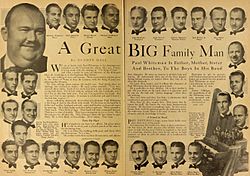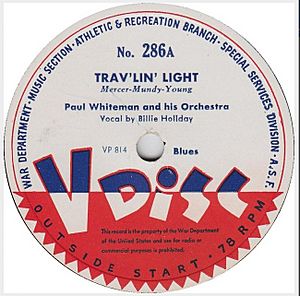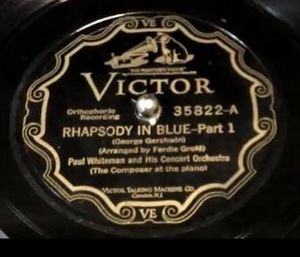Paul Whiteman facts for kids
Quick facts for kids
Paul Whiteman
|
|
|---|---|

Whiteman, c. 1934
|
|
| Background information | |
| Birth name | Paul Samuel Whiteman |
| Born | March 28, 1890 Denver, Colorado, U.S. |
| Died | December 29, 1967 (aged 77) Doylestown, Pennsylvania |
| Genres | Jazz, classical, pop |
| Occupation(s) | Bandleader, composer |
| Instruments | Viola, violin |
| Years active | 1907–1960s |
| Associated acts | Bix Beiderbecke, Frankie Trumbauer, Joe Venuti, Eddie Lang, Bing Crosby, The Rhythm Boys, Jimmy Dorsey, Tommy Dorsey |
Paul Samuel 'Pops' Whiteman (born March 28, 1890 – died December 29, 1967) was an American bandleader, composer, and violist. He led one of the most popular dance bands in the United States during the 1920s and early 1930s. People often called him the "King of Jazz."
Whiteman's band made many successful recordings. Some of his most famous songs include "Whispering", "Valencia", and "Three O'Clock in the Morning". He led a large group of musicians and mixed different music styles. For example, he combined symphony music with jazz. He famously introduced Rhapsody in Blue by George Gershwin.
Paul Whiteman recorded many jazz and pop songs. These included "Wang Wang Blues" and "Mississippi Mud". His popularity slowed down in the mid-1930s when swing music became popular. But he made a comeback in the 1950s with his own TV show, Paul Whiteman's Goodyear Revue.
Some people debate Whiteman's role in early jazz. Some say his music was too organized and not true jazz. Others say he truly loved jazz. He worked with Black musicians as much as he could during a time of racial segregation. His bands also featured many talented white musicians.
Music critic Scott Yanow said Whiteman's orchestra played "very good jazz." He noted that Whiteman's band was very skilled. They played everything from pop songs and waltzes to jazz. Even Duke Ellington, another famous musician, called Whiteman the "King of Jazz."
Contents
About Paul Whiteman
His Early Life
Paul Whiteman was born in Denver, Colorado. He grew up in a musical family. His father, Wilburforce James Whiteman, was in charge of music for the Denver Public Schools for 50 years. His mother, Elfrida, used to be an opera singer. Paul's father wanted him to learn an instrument. Paul chose the viola.
His Music Career
Paul Whiteman was very good at the viola. He joined the Denver Symphony Orchestra in 1907. Later, he played with the San Francisco Symphony in 1914. After World War I, he started the Paul Whiteman Orchestra.
In 1920, he moved his band to New York City. They started recording music for the Victor Talking Machine Company. These recordings became very popular. Whiteman became the most famous band director of the 1920s. Most dance bands had 6 to 10 musicians. Whiteman's group was much larger, sometimes with up to 35 musicians. By 1922, he managed about 28 bands and earned over $1,000,000 a year.
In 1926, Whiteman met a young reporter named Billy Wilder in Vienna, Austria. Whiteman liked Wilder and took him to Berlin. This helped Wilder make connections in entertainment. He later became a famous Hollywood writer and director.
Whiteman signed with Columbia Records in 1928. He later returned to RCA Victor in 1931.
"The King of Jazz"
In the 1920s, the media called Whiteman "The King of Jazz." He had a special way of playing jazz music. He liked to organize and arrange it in his own style.
Many jazz musicians believe that making up music on the spot (improvisation) is key to jazz. Whiteman, however, thought jazz could be better with formal, written arrangements. Still, his recordings were very popular. For many Americans, his style was the first jazz they ever heard. Whiteman created more than 3,000 musical arrangements.
For over 30 years, Whiteman, known as "Pops," helped new musicians, singers, and composers. In 1924, he asked George Gershwin to write Rhapsody in Blue. Whiteman's orchestra performed it first, with Gershwin playing the piano. Another famous piece in Whiteman's shows was Grand Canyon Suite by Ferde Grofé.
Whiteman hired many of the best jazz musicians for his band. These included Bix Beiderbecke and Jack Teagarden. He also wanted to hire talented African American musicians. However, his managers told him that doing so would harm his career. This was because of racial segregation at the time.
He created music for six Broadway shows. He also made over 600 phonograph recordings. His song "Valencia" was number one for 11 weeks in 1926. It became the top record of that year.
Movies, Radio, and TV
Paul Whiteman appeared in several movies. He played himself in the 1945 film Rhapsody in Blue, which was about George Gershwin. He also appeared in The Fabulous Dorseys (1947) and the musical King of Jazz (1930).
Whiteman was also active in early radio. In 1928, he starred in a big NBC radio show called The Victory Hour. Later, he had a weekly radio show for Old Gold Cigarettes. He became very busy in radio, hosting many different programs.
In the 1940s and 1950s, Whiteman worked as a music director for the ABC Radio Network. He also hosted Paul Whiteman's TV Teen Club on ABC-TV from 1949 to 1954. This show was an amateur hour for young people. A young Dick Clark even read commercials for the show. Whiteman's TV-Teen Club helped inspire the famous show American Bandstand.
He also continued to be a guest conductor for many concerts. He retired from music in the early 1960s.
His Personal Life
Paul Whiteman lived on a farm in New Jersey from 1938 to 1959. After selling the farm, he moved to New Hope, Pennsylvania. He passed away from a heart attack on December 29, 1967, in Doylestown, Pennsylvania. He was 77 years old.
Paul Whiteman's Legacy
The Paul Whiteman Orchestra introduced many famous jazz songs in the 1920s. These include "Hot Lips", which was in the movie The Color Purple (1985). Other songs were "Mississippi Mud" and "From Monday On," sung by Bing Crosby. He also introduced "Grand Canyon Suite" and "Mississippi Suite" by Ferde Grofé. Of course, he premiered "Rhapsody in Blue" by George Gershwin.
Many musicians were influenced by Paul Whiteman's Orchestra. This includes Herb Alpert and Al Hirt.
His Compositions
Whiteman helped write the popular song "Wonderful One" in 1922. He worked with Ferde Grofé and Dorothy Terris on this song. It became a top hit in 1923. Many artists recorded "Wonderful One," including Glenn Miller and Doris Day.
He also co-wrote "Whiteman Stomp" with Fats Waller and Jo Trent. The Fletcher Henderson Orchestra first recorded this song in 1927. Whiteman's own orchestra also recorded it later that year.
Whiteman co-wrote "My Fantasy" in 1939. This song was based on a theme from the opera Prince Igor by Alexander Borodin.
Awards and Honors
Paul Whiteman received many awards for his music.
- In 2006, his 1928 recording of Ol' Man River with Paul Robeson was added to the Grammy Hall of Fame.
- In 1998, his 1920 recording of "Whispering" was also inducted into the Grammy Hall of Fame.
- His 1927 recording of "Rhapsody in Blue" was inducted into the Grammy Hall of Fame in 1974.
- He was added to the Big Band and Jazz Hall of Fame in 1993.
- He has two Stars on the Hollywood Walk of Fame.
- Two of his songs, "Rhapsody in Blue" and "Whispering," are listed in the National Recording Registry.
- In 2016, Paul Whiteman was inducted into the Colorado Music Hall of Fame.
Major Recordings
Here are some of Paul Whiteman's most important and popular recordings:
- "Whispering" (1920): #1 for 11 weeks. It sold almost two million copies.
- "The Japanese Sandman" (1920): #1 for 2 weeks.
- "Wang Wang Blues" (1921): #1 for 6 weeks.
- "My Mammy" (1921): #1 for 5 weeks.
- "Cherie" (1921): #1 for 6 weeks.
- "Say It With Music" (1921): #1 for 5 weeks.
- "Play that 'Song of India' Again" (1921): #1 for 5 weeks.
- "Hot Lips (He's Got Hot Lips When He Plays Jazz)" (1922): #1 for 6 weeks. This song was in the movie The Color Purple.
- "Do It Again" (1922): #1 for 2 weeks.
- "Three O'Clock in the Morning" (1922): #1 for 8 weeks.
- "Stumbling" (1922): #1 for 6 weeks.
- "Wonderful One" (1922): Music by Paul Whiteman and Ferde Grofé.
- "I'll Build a Stairway to Paradise" (1923): #1 for 1 week.
- "Parade of the Wooden Soldiers" (1923): #1 for 7 weeks.
- "Linger Awhile" (1924): #1 for 4 weeks.
- "What'll I Do" (1924): #1 for 5 weeks.
- "Somebody Loves Me" (1924): #1 for 5 weeks.
- "Rhapsody in Blue" (1924): With George Gershwin on piano.
- "All Alone" (1925): #1 for 3 weeks.
- "Birth of the Blues" (1926): #1 for 4 weeks.
- "Valencia" (1926): #1 for 11 weeks, the top record of 1926.
- "My Blue Heaven" (1927): #1 for 1 week.
- "In a Little Spanish Town" (1927): #1 for 8 weeks.
- "Whiteman Stomp" (1927).
- "Washboard Blues" (1927): With Hoagy Carmichael singing and playing piano.
- "Rhapsody in Blue" (1927): This electrical version was inducted into the Grammy Hall of Fame.
- "From Monday On" (1928): With Bing Crosby and The Rhythm Boys.
- "Mississippi Mud" (1928): With Bing Crosby and Bix Beiderbecke.
- "Ol' Man River" (1928): First version with Bing Crosby, #1 for 1 week.
- "Ol' Man River" (1928): Second version with Paul Robeson singing. This was inducted into the Grammy Hall of Fame.
- "Among My Souvenirs" (1928): #1 for 4 weeks.
- "Ramona" (1928): #1 for 3 weeks.
- "Together" (1928): #1 for 2 weeks.
- "My Angel" (1928): #1 for 6 weeks.
- "Great Day" (1929): #1 for 2 weeks.
- "Body and Soul" (1930): #1 for 6 weeks.
- "All of Me" (1932): #1 for 3 weeks.
- "Willow Weep for Me" (1933): #2 chart hit.
- "It's Only a Paper Moon" (1933): Used in the 1973 movie Paper Moon.
- "Trav'lin' Light" (1942): With Billie Holiday singing.
Grammy Hall of Fame
The Grammy Hall of Fame honors recordings that are at least 25 years old and have special "qualitative or historical significance." Paul Whiteman's recordings have been honored multiple times.
| Year recorded | Title | Genre | Label | Year inducted | Notes |
|---|---|---|---|---|---|
| 1920 | "Whispering" | Jazz (single) | Victor | 1998 | |
| 1927 | "Rhapsody in Blue" | Jazz (single) | Victor | 1974 | |
| 1928 | "Ol' Man River" | Jazz (single) | Victor | 2006 |
See also
 In Spanish: Paul Whiteman para niños
In Spanish: Paul Whiteman para niños









